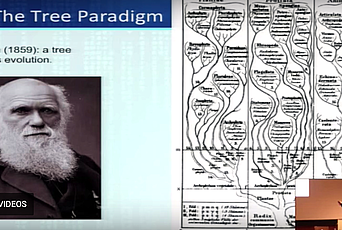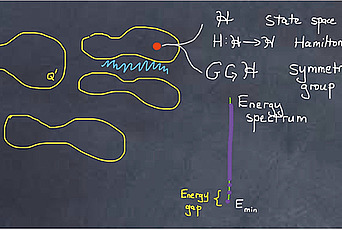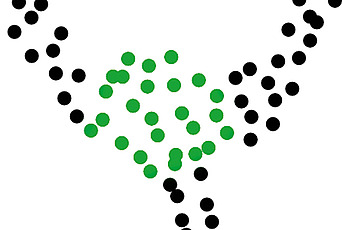Identifying Order in Complex Systems

What explains “the unreasonable effectiveness” of mathematics, as the late Princeton University physicist Eugene Wigner phrased it, in answering questions about the real world?
Natural phenomena could have been structured in a way that couldn’t be understood at all, or that could only be understood using another method. Instead, we repeatedly find they are understood using the most precise tools we have for studying something: mathematics.
Applied mathematics historically has concerned quantitative areas, such as calculus, rather than qualitative areas, such as topology (the study of properties that are preserved in geometric figures despite continuous deformations). Of interest to Robert MacPherson, Hermann Weyl Professor in the School of Mathematics, is the possibility that topology has applications––beyond high-energy physics, where it has proven very fruitful (for example, Chern-Simons theory)––to areas such as biology, or the breaking of ocean waves.
“What would it be to understand the breaking wave?” asks MacPherson. “Well, certainly not understanding every little bubble of every foam piece. Quantitative mathematics is not going to capture whatever is going on there. There is just too much data. What would you do with it? It is not useful. It doesn’t answer any interesting questions. What you want to extract is something simpler that you can deal with. And you know there is something simpler there because every wave that comes up breaks in more or less the same way. It is not as if it is some totally chaotic thing that can’t be understood at all. You can see that there is order in this, because it happens repeatedly.”
During the last century, topology developed largely in Princeton due to the foresight of topologist Oswald Veblen, who became the Institute’s first Professor in 1932 and started Princeton on the trail of being a world center in the field. One of MacPherson’s prized documents is a copy, previously owned by André Weil, Professor in the School of Mathematics (1958–98), of Analysis Situs by Henri Poincaré that was published in 1895. “I love it because it has André Weil’s personal handwritten notes,” says MacPherson. “This is the paper that established the whole subject of topology. In the introduction he writes about why he is doing this and why a new language is needed. His justification is that it actually comes up in applications, and he gives examples of three applications in which topology had come up.”
What is striking to MacPherson is that despite Poincaré’s citation of these applications topology has not been developed with applications in mind, at least not until recently. “In fact, most topologists have not thought about applications at all,” says MacPherson. “It is my belief that these qualitative topological methods are very powerful in describing the real world.”
Several years ago, MacPherson started attending graduate courses in the engineering department at Princeton University with the idea that there were problems involving materials that could benefit from topological thinking. Two years ago, MacPherson with David Srolovitz, then Chair of Princeton University’s Department of Mechanical and Aerospace Engineering, used topology to discover a three-dimensional (and higher) solution to an open problem that had existed since 1952 when John von Neumann, Professor in the School of Mathematics (1933–57), solved it in two dimensions.
Von Neumann derived an exact formula––R=K (V– 6) where R is the growth rate of the area of a cell, K is a constant depending on the temperature and the material, and V is the number of vertices of the cell. Von Neumann’s formula applies to the cells formed by crystals in a metal or a ceramic, or by bubbles in a foam. What made the three-dimensional solution to the problem challenging is that a three-dimensional cell can curve in many complicated ways whereas a cell boundary in two dimensions can curve in essentially only one way.

MacPherson and Srolovitz generalized von Neumann’s formula for three-dimensional cell growth as follows: R=K (E – 6L) where E is the length of all the edges of the cell and L is the “mean width” of the cell, a measure of its linear size. The mean width L is a “natural” concept from pure mathematics that was developed by many mathematicians, including Hermann Weyl (Professor, 1933–55) and John Milnor (former Professor, 1970–90) at the Institute.
Three-dimensional cellular structures in hard materials such as metals or ceramics, and in soft materials such as foams, influence the material properties that are important in applications, such as strength and magnetization of hard materials, or complex fluid behavior in soft materials, such as in breaking waves. This is why the three-dimensional von Neumann formula is useful. The study of these ideas continues at the Institute. In the upcoming academic year the School of Mathematics will host two materials scientists—Jeremy Mason, a postdoctoral specialist in hard materials from the Massachusetts Institute of Technology, and Randall Kamien, Professor at the University of Pennsylvania, who studies soft materials.
MacPherson with Konstantin Mischaikow of Rutgers, the State University of New Jersey, organized a series of seminars last spring to discuss the current and future applications of topological techniques, both theoretical and computational, for organizing and understanding the data of a breadth of complicated phenomena—from neural activity to laboratory fluid flows.
The seminars, which alternated between the Institute and Rutgers and will continue this fall, featured three talks for a broad interdisciplinary audience––one by a mathematician with techniques that might solve a problem; one by a scientist with problems that might be solved; and one by an expert at computer algorithms who could study whether these techniques predict a particular solution. “We’ll have to wait twenty years,” says MacPherson, “to see whether we are witnessing the beginning of a significant new connection between topology and applications.”


